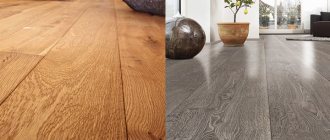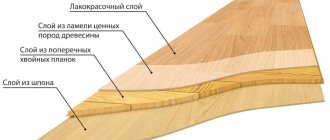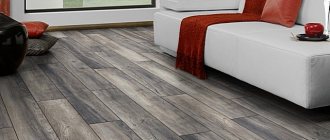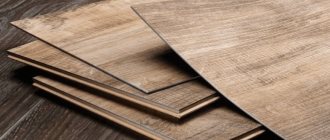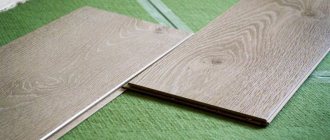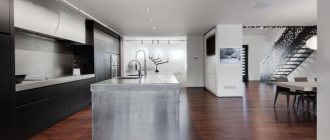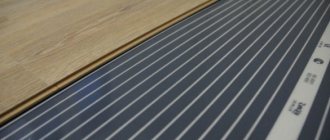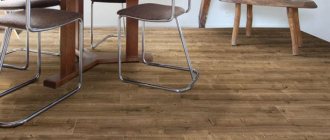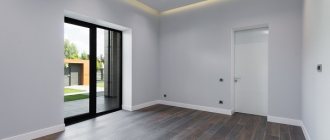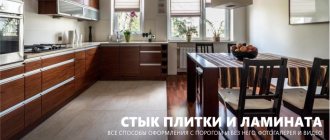September 17, 16:10 Read: 7992 Rated: 100
The variety of modern floor coverings today is very large. They differ in appearance, color, material and price range even within the same category. In such a variety, the eyes simply run wild, and sometimes it is not clear where to stop. Today we will tell you what to look for when choosing and help you find your ideal floor.
Let's focus on the leaders
In this article we will not consider exotic and expensive flooring options, because their choice is most often conscious and dictated by specific requirements. Let's focus on the main market leaders, between which 90% of customers usually choose. And these are only three types of coatings:
- laminate, familiar to all of us ;
- relatively new, but already beginning to literally “break” the market for interior coatings, quartz-vinyl tiles;
- natural wood coverings - parquet and engineered boards .
Rules for operating the coating
Often reviews of quartz vinyl laminate indicate its high degree of reliability. But this will only be relevant in cases where it is properly cared for. First of all, this applies to the timely removal of stains of various origins.
To do this, it is recommended to use a biodegradable cleaner that will not damage the polymer surface. Before use, you should read the instructions. In some cases, after applying the product, it does not need to be washed off with water. If the damage is significant, you need to use special vinyl polishes.
You can replace defective tiles or a section of rolled linoleum yourself. To do this, you should dismantle part of the covering and clean the floor surface from the adhesive base. Having cut out a new piece, it is installed using the technology described above.
If you need to find out how practical vinyl laminate is, reviews from professionals will help you decide. It is only important to choose the right coating model, as well as follow the technology for its installation. In this case, the service life can be from 10 to 15 years.
© 2022 prestigpol.ru
Laminate
Laminate firmly holds first place in popularity among all floor coverings, and there are a number of reasons for this. The prevalence of laminate is beyond doubt - 70% of the sales of any flooring salon come from it. In our comparison, we will start from the laminate, comparing other coatings with it. After all, this is the most obvious, at first glance, choice for almost everyone who is not yet closely familiar with the alternative options.
Wear resistance classes
Before we begin our race for the perfect floor, let's understand the concept of wear resistance class. This is an important parameter to consider when purchasing both laminate and quartz-vinyl flooring.
The class is indicated by a number; the higher it is, the better the floor tolerates loads, wears out more slowly, and is more resistant to impacts. But the cost per meter is also rising. The first number indicates the subgroup and general purpose, the second - the strength of the top layer.
Classes 21-24 are cheap, but very fragile, and therefore have practically disappeared from stores. 41-44 can withstand the harsh conditions of commercial premises, but are expensive and very rare. The most popular classes are:
- Class 31 can withstand light loads, is suitable for rooms with low traffic (bedrooms, dressing rooms), there may be a loud knock from heels;
- Class 32 is suitable for residential premises with high intensity of use (for example, living rooms or children's rooms);
- Class 33 is suitable for commercial premises with medium to high loads;
- Class 34 is chosen for commercial premises with maximum load, but
This class is not found among European manufacturers.
Advantages of laminate
Let's start the review of the characteristics of laminate with its positive aspects, which made it the absolute top among floor coverings.
Easy to install. The ease of laying laminate flooring and the relatively small requirements for the subfloor have made laminate flooring a favorite floor for workers and builders. If you wish, you can even lay the laminate flooring yourself by studying a few videos on YouTube - that’s how simple it is! There are two options for laying laminate: lock and adhesive. The first one is easier, but in principle you can master both with your own hands. For those who are not familiar with the technology, we will tell you more about installation methods in this article just below.
Aesthetics, appearance. The variety of shades and patterns of laminate flooring is simply amazing. There is no other coating with such a variety of textures and colors. At the same time, the degree of similarity often varies: one coating is literally indistinguishable from a natural floor, while on the other the unnaturalness is immediately noticeable. But the bottom line here is clear - if you are looking for laminate, you are guaranteed to find one you fall in love with.
Price. This is one of the key factors that made laminate so popular. A fairly simple production technology made it possible to divide laminate into a whole range of price categories, starting with 200-300 rubles and ending with 3000 rubles per square meter. This is exactly the floor that will suit any budget. Keep in mind that the price of a truly high-quality, durable laminate still starts at 700-800 rubles per square meter.
Strength. Despite the variety of laminate wear resistance classes, in general it has established itself as a fairly durable material. The 32nd class laminate flooring we recommend can withstand ordinary household loads, but without excesses: the fall of sharp and heavy objects can leave chips on the coating.
Disadvantages of laminate
Moisture protection. The main enemy and disadvantage of laminate has always been and remains water. When laying it, there are always gaps left, which can expand and contract slightly depending on the microclimate. If water gets into them, it is immediately absorbed into the ends of the lamellas. As a result, the laminate swells, warps and deteriorates. That is why puddles of spilled water, high humidity and even small floods are destructive for laminate flooring. Because of this drawback, laminate flooring is not recommended for installation in the kitchen and hallway areas.
Care and contamination. The floor can be washed with a slightly damp cloth and non-aggressive detergents. Do not use solvents or compounds with abrasive particles - they will quickly damage the top layer. Ordinary household dirt can be cleaned quite easily, but complex dirt will require considerable effort to remove. Difficulties also arise with deep texture or chamfered edges - dust gets clogged up in them.
Tactile sensations. Laminate is almost always smooth to the touch; its synthetic origin can be felt without much difficulty. It is warmer than tiles and porcelain stoneware, but certainly cooler than any natural wood.
Environmental friendliness. The main layer of the laminate consists of wood chips and synthetic resin binders. And it is precisely these substances that cause concern: they contain toxic formaldehyde. But in varieties that are intended for domestic premises, and not for commercial ones, its concentrations are safe.
Sound properties. Sonorous material, you will always hear the clicking of heels and the clatter of pets' claws. Laminate flooring can creak and dry out over time.
Installation methods: lock vs glue
Let's take a little break from our comparison and take a brief look at the two main methods of laying flooring.
The first and most popular method, due to its simplicity, is the castle method. This type of flooring is laid on a backing made of cork, polyurethane foam or plywood (in the case of parquet boards).
NB! Important! The surface of the subfloor prepared for laying should be flat, and the underlay should not be too thick.
On one side of each lamella there is a protrusion that is inserted into the previous part. Then the lock snaps into place. This way the entire coating is collected.
The result is a so-called “floating floor” - a surface that is not firmly attached to the subfloor. The parts must be able to expand and change position, so they leave small gaps near the walls.
The second installation method is glue. This type of flooring is usually more flexible and has an adhesive base on the underside. The protective film is removed from it and laid on the floor. The next part is installed in the same way, with an overlap on the specially protruding part of the previous one.
NB! Attention! The surface of the subfloor for glue must be prepared especially carefully: all cracks must be sealed, perfectly leveled and primed.
Quartz vinyl. Why is he so good?
This coating appeared recently, but many have already appreciated its qualities. The tiles are made from quartz sand and synthetic compounds. It can be square or rectangular in shape. Like laminate, there is a decorative layer with a pattern and a protective coating on top.
NB! Attention! There is a similar material - vinyl or PVC tiles. The composition does not include quartz and a layer of fiberglass, so it is less strong and durable (class 21-22 versus 34 or 43). These two materials should not be confused.
The main advantages of quartz vinyl, which made it a daring newcomer challenging laminate, are strength and moisture resistance .
Its strength corresponds to wear resistance class 34 (recommended for home) and wear resistance class 43 (for commercial premises). Almost any quartz vinyl is stronger than laminate in the same price category.
The moisture resistance of quartz vinyl made it a truly revolutionary material. It can be installed in the kitchen, bathrooms and even on an unheated balcony. Whatever you do with quartz vinyl in terms of water and humidity, know that it doesn’t care at all! It can withstand any flood and remain in its original form when the rest of the apartment has already been destroyed by floods.
For those who love a single “wood-like” floor everywhere, from the hallway to the kitchen work area, this is simply a salvation. There is no need to worry about joining laminate and tiles, as well as organizing heated floors for the latter. Quartz vinyl itself is quite warm, especially with a thickness of 4-5 mm. But it, like laminate, is still far from natural wood.
An additional bonus: quartz vinyl, in contrast to the loud laminate, dampens noise due to its elasticity. It can be called a kind of soundproofing of the floor.
The disadvantages of quartz-vinyl tiles lie in the youth of this type of coating. This is the minimum price threshold and a variety of shades. If laminate can be found even for ultra-economical repairs, then for “quartz” the starting price starts from 800-900 rubles per meter, and high-quality and aesthetic options start from 1300-1500 rubles per “square”.
The variety of textures of quartz vinyl is gaining momentum every year, but so far it is clearly losing to laminate both in the number of manufacturer brands and in the number of collections. Finding the quartz vinyl of your dreams will be more difficult than laminate. But what's the point in repairing if everything is easy and simple, right?
Let us summarize our comparison. Quartz vinyl, being in many ways similar in properties to laminate, is devoid of its two main disadvantages - it is not at all afraid of water and will adequately withstand the claws of your Doberman or dishes flying down.
Our expert verdict: in the average price category of 1,500 rubles per meter, this is definitely the number one choice if you don’t mind the smaller variety of patterns and textures.
Well, now let’s turn our attention to natural wood.
What are quartz vinyl tiles?
Quartz vinyl tiles also have a multilayer structure - PVC is used as the base, and quartz or chalk are the binding components. Polyvinyl chloride provides stability and ductility, while quartz is responsible for strength and durability. Polyurethane is used as a protective layer.
The difference between quartzvinyl is its moisture resistance, so it is recommended to inject it in rooms with high levels of humidity or where there is a risk of spilling something.
The coating also has other advantages:
- elasticity, which allows you to relieve tension when walking;
- resistance to ultraviolet radiation and dyes;
- high wear resistance;
- ease of care;
- When heavy objects fall from a great height, there are no traces of chips and cracks left on the surface of the dies, as on laminate.
Parquet and engineered boards
Wooden floors are the most respectable option; with them, the interior immediately looks more luxurious and more expensive. It’s not for nothing that the most popular color options for artificial turf are made to look like wood.
First, let's look at the differences between the most popular wood flooring options - parquet and engineered wood. Both materials consist of several layers glued together. They are shaped like boards. They are often tinted or brushed, and must be varnished on top to protect them from dampness and scratches.
Strictly speaking, engineered wood can be called any wood floor covering that consists of several layers. But now these words mean a two-layer structure: plywood with a decorative layer of valuable wood glued onto it. Plywood stably retains its shape (length and width), but can twist when humidity changes. Therefore, the engineered board is glued to the subfloor.
The parquet board consists of three layers of wood (without plywood), the top of which is decorative and more valuable. Thanks to the strong connections and the locking connection, it does not get twisted, so the parquet board is laid in a floating manner. This is much easier than gluing engineering. Therefore, you can lay the parquet board yourself. And even take it apart and put it back together (for example, when moving).
We will begin our review of the characteristics of parquet and engineered wood boards not with the advantages, but, on the contrary, with the disadvantages. This will help you decide whether you need natural wood on the floor at all.
The first and main drawback is the price. Yes, both hardwood and engineered wood floors are much more expensive than laminate or vinyl flooring. If your budget for the floor is less than 3,000 rubles per meter of the coating itself (without glue and work), you should not even seriously consider purchasing wooden floors. Note that 3,000 rubles/m2 today is the minimum with which to start your search.
The second serious drawback of wood is its capriciousness. Despite the varnish coating and a good choice of wood for the top layer, wood always remains “sissy” in comparison with laminate, and even more so in comparison with quartz-vinyl tiles. Both parquet and engineered boards are demanding in terms of care and require careful use. Getting scratches and chips on such a floor, especially in a large family with children and pets, is a matter of time. The advantage is that on the surface of natural wood, scratches and even cracks often look natural, and in some styles they even look advantageous. It is also necessary to protect the wood from excessive dampness: water causes the boards to swell and warp when dry. You can’t put wood in the kitchen, or you’ll have to replace it soon.
NB! Contrary to the above, a pleasant fact for you will be that, unlike previous options, a wooden floor can be updated. The surface is scraped with a special machine and re-varnished. The top layer becomes thinner, but minor defects can be removed. The thicker the top layer, the more times the floor can be restored.
The third disadvantage of the board obviously follows from the very concept of natural wood. As befits the latter, parquet and engineered boards can dry out over time, change their geometry and begin to creak, especially if they are not installed with sufficient quality and care. Therefore, if you have already decided to lay a wooden floor, our urgent advice is not to skimp on your hands, entrust this task to trusted craftsmen.
The one and only reason to buy a board
Yes, you read the title correctly. There is exactly one reason to buy parquet and engineered wood. This is a tree. Real, natural wood. It is warm, it is incredibly pleasant to the touch (once you walk barefoot on this floor, you will not confuse it with anything else), it is 100% environmentally friendly and looks indecently beautiful on the floor of absolutely any interior, from modern minimalism to rough, brutal loft.
What kind of substrate is best to use under it?
In materials for flooring made of polyvinyl chloride, it will not be possible to find an answer based on the type of substrate under it, since the concept of “vinyl laminate” currently includes several completely different materials:
- PVC floor tiles (regular covering);
- self-adhesive panels (Contesse);
- vinyl laminate with a locking connection method (quartz vinyl).
There is no point in laying the backing under the tiles and lamellas on glue - there should be no intermediate link (layer) between the base of the floor and the glue. A number of interlocking laminate manufacturers also believe that an underlay is not needed. The inscription on the packaging will help you figure out when it is necessary to lay a substrate, where this point is necessarily specified: “needed, not needed.”
If laying the underlay according to the flooring installation technology is necessary, you can buy:
- cork backing. This is the most effective material that allows you to compensate for unevenness of the base, retain heat well and absorb sound waves. Considering the small thickness of the lamella board and its flexibility, the optimal thickness of the backing is 2 mm (on the forums, visitors note that with a thicker backing, the floor begins to sag under the weight of an adult);
- "Izolon" is the cheapest material. It is necessary to lay foamed polyethylene with a thickness of 3 mm. Under the weight of the floor covering, it will shrink to 2 mm, which will compensate for unevenness of the base;
- "Tuplex" . This underlay perfectly compensates for unevenness on the floor base and is a good heat and sound insulating material. Here, too, the optimal thickness is 2 mm;
- coniferous substrate - guarantees compensation for minor irregularities and good sound insulation. One of the best options when installing a “warm floor” is to ensure uniform distribution of heat over the surface of the laminate.
Final choice
Having analyzed all the advantages and disadvantages of the three main types of flooring, we move on to the most important thing - summing up the comparison. Let's put aside the issue of texture variety, since in our experience it is much less important than practical properties and price.
The first step you should take on the path to the perfect floor is to decide on a budget. Given at least 3,000 rubles per square meter of coverage, our choice comes down to aesthetics and environmental friendliness (board) versus practicality and indestructibility (grade 43 quartz-vinyl, 5-6 mm thick).
With a more modest budget of up to 2000-2500 rubles per meter, we recognize quartz-vinyl tiles (grade 34) as the clear winner, however, the more modest the budget, the more often the scales will lean toward laminate. The latter is becoming the only option in the economy segment up to 1,500 rubles per square meter.
Comparison table of materials
The table shows the difference in performance characteristics of floor coverings.
| Options | PVC tiles | Quartz vinyl |
| Durability | Limited to 10 years | Minimum 25 years |
| Ability to withstand mechanical stress | Average | High |
| Soundproofing properties | Mid: Reduces loud sounds to conversation level | High: extraneous noise is heard as a whisper |
| Thermal conductivity | Average | Bad: it conducts cold slowly, a heated one takes a long time to cool down |
| Wear resistance | Average | Maximum |
| Can be used as a finishing coating for heated floors | Selected species | Applicable |
| Antistatic qualities | Average | Virtually no dust attraction |
In other respects, these flooring materials have no differences.
They are characterized by high slip resistance, resistance to fading in the sun, and ease of installation. When we compare PVC and quartz vinyl coatings, the material with a sand filler has clear advantages.
Typical examples
To simplify the choice for many of our readers, we asked one of the designers of our studio, Oksana Polyanskaya, to share her recommendations for some typical cases related to the choice of flooring.
First example. Repair for delivery
“The most important thing here is to apply the most “non-killable” coating. Tenants often do not take care of other people's housing, and it falls into disrepair much faster than their own.
An apartment in poor condition is less rentable, and floors that have suffered from use and constant moving of furniture are often the first thing that catches your eye. At the same time, repairs require time, during which the housing will remain idle. Therefore, here my recommendation is clear: only quartz-vinyl.”
Second example. Economy repairs on credit without extra money
“In this case, the choice is also clear: look exclusively at laminate, which is ahead of all other coatings in the lower price segment by a margin. When purchasing, you should focus primarily on the wear resistance class and reliability of the manufacturer. The floor may not be as beautiful and fashionable, but it will last longer without replacement. By the way, with discounts on various promotions or with the help of a designer, you can purchase quite decent laminate options even cheaper than 1,000 rubles per meter.”
Third example. Large family with a dog, a cat and a pet canary
“Another case where quartz-vinyl tiles definitely win due to their resistance to external influences and moisture protection. If you plan to live in your apartment for many years and do not want to see constant reminders on the floor that you have a big happy family (there are simpler ways for this), your choice is 43-grade quartz vinyl. Even if you're doing a relatively budget-friendly renovation, I'd still highly recommend going over your flooring budget and splurging on a durable finish."
Linoleum
I sorted it out and forgot about it. We replaced it with a more economical option - linoleum. It feels good. Modern linoleum has an almost imperceptible smell (and even then at first), a wide range of colors, and a variety of textures.
And installation is simple: just cut the slit and that’s it. It doesn’t crack, doesn’t crumble, doesn’t crack, doesn’t warp, but... it tears well. Our Labrador Bucks proved it. One day, returning from work, we discovered a hole in the lid and a happy dog's face.
The hole was repaired and a bedside table was placed in place of the injury. The dog grew up and stopped chewing everything, but could still run. Thus, running in circles at the sound of the refrigerator opening and stopping at his plate in the kitchen, Bex's sharp claws caused yet another injury to our "under the laminate" linoleum.
